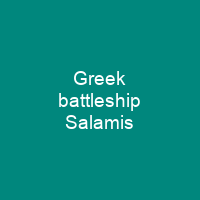Discovering the Tale of Salamis: A Greek Capital Ship in Turbulent Times
Imagine a ship, a giant of its time, destined to be the pride of Greece’s fleet but never fully realized. That’s the story of the Salamis, a partially constructed capital ship that was ordered from AG Vulcan shipyard in Hamburg, Germany, back in 1912.
The Birth and Early Days
Following the Greco-Turkish War of 1897, Greece faced the challenge of rebuilding its fleet to counter Ottoman naval expansion. In 1908, the Greek Navy sought proposals from foreign shipyards, including Vickers and Armstrong-Whitworth. However, these plans were not pursued by the government.
Then came the Ottomans, who purchased German pre-dreadnought battleships and a dreadnought in 1911. This prompted Greece to consider ordering new capital ships of its own. Rear Admiral Lionel Grant Tufnell advocated for purchasing an armored cruiser and modernizing the Salamis base, which was supported by Prime Minister Eleftherios Venizelos.
The Greek government decided on the Salamis ship, but it would never see completion due to World War I. The armament for this behemoth was ordered from Bethlehem Steel in the United States, but couldn’t be delivered due to the British blockade of Germany and were instead sold to Britain to arm monitors.
The Design and Construction
Initially, the design called for a 458 ft long ship with a displacement of 13,000 tons. The armament included six 14-inch guns, eight 6-in guns, and two 45 cm torpedo tubes. However, tensions leading up to the First Balkan War led to several revisions, including an increase in displacement by 50%, four twin-gun turrets, and superfiring pairs of main batteries.
The new contract was adopted on December 23, 1912, with Salamis expected to be delivered by March 1915 at a cost of £1,693,000. The ship would have been significantly faster than most contemporary battleships, powered by three AEG steam turbines with a top speed of 23 knots.
Primary armament consisted of eight 14-inch /45 caliber guns in four twin-gun turrets, two forward and two aft, with additional secondary armament consisting of twelve 6-inch /50 caliber guns in casemates amidships and six 75mm quick-firing guns. The ship had an armored belt up to 250.8 mm thick in the central section, main deck armor up to 73 mm, and lightly armored conning tower.
The War and Beyond
Construction began on July 23, 1913, but work stopped in December 1914 due to World War I. The Greek government paid AG Vulcan only £450,000 for the ship and was forced to accept an incomplete hull. A dispute arose between Greece and AG Vulcan over payment, with the Greek navy refusing to accept the incomplete hull and Vulcan suing for reimbursement of advance payments.
The arbitrators ultimately determined that Greece owed £30,000 to AG Vulcan, and the ship was broken up for scrap in 1932. The fate during the war is unclear, but it’s believed that it may have been towed to Kiel or used as a barracks ship.
The Legal Battle
A dispute over the Greek dreadnought Salamis went before the Greco-German Mixed Arbitral Tribunal in 1924. The tribunal sided with Vulcan, and Greece considered responding positively to an offer from Vulcan to modernize the ship in 1928. However, the cost of completion would have been too high, and instead, Greece decided to retain two old pre-dreadnoughts for coastal defense against a Turkish battlecruiser.
Conclusion
The story of Salamis is a testament to the complexities of naval strategy in early 20th-century Europe. It’s a reminder that even with the best intentions and plans, external factors like war can disrupt even the most ambitious projects. The tale of this partially constructed capital ship serves as a metaphor for the challenges faced by nations in maintaining their maritime power during times of conflict.

You want to know more about Greek battleship Salamis?
This page is based on the article Greek battleship Salamis published in Wikipedia (retrieved on November 29, 2024) and was automatically summarized using artificial intelligence.







